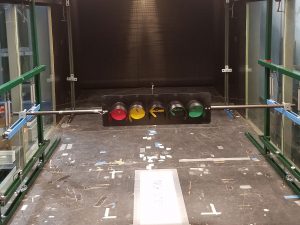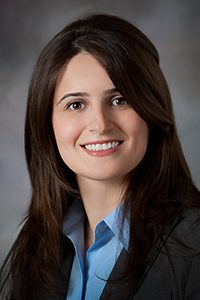Joint research looks to uncover a design for longer-lasting traffic signal structures
When you’re Alice Alipour, you go to the source of the problem. That’s exactly what the structural engineer is doing for her latest project.
The Project
| Profs. Alice Alipour and Partha Sarkar | |
This month, the National Cooperative Highway Research Program (NCHRP) informed Alipour that she and Iowa State University (ISU) aerospace engineering professor Partha Sarkar earned Innovations Deserving Exploratory Analysis (IDEA) funding. The researchers’ project, “Development of a Novel Aerodynamic Solution to Mitigate Large Vibrations in Traffic Signal Structures,” explores methods for extending the usage life of structures like traffic lights or electronic variable message signs.
“There are characteristics in the structure that, if you can amplify those characteristics, they will help to dampen out the vibrations from the wind,” Alipour, a professor in the civil, construction and environmental engineering department, explained.
The problem
The fix starts by looking at the main culprit causing sign fatigue: vibrations. Right now, many signs employ a cantilevered arm. The cantilevered arm is the section of a traffic light parallel to the ground where the signals are placed. High winds can cause traffic signs to gallop. Galloping occurs when forces like wind cause large movements – or vibrations – in the arm of the sign. The galloping is a steady, usually rhythmic movement. That movement can lead to fatigue and ultimate failure of the traffic signal.
“In this project, we proposed to approach this from a whole different perspective,” Alipour said. “Rather than solving the consequences of this vibration, we’re going to go and completely wipe out the problem. Design these structures so the vibration—these large vibrations, these amplitudes—doesn’t happen anymore.”
Searching for solutions
There are several ways to mitigate the damage, like larger connecting sections or metal belts to reinforce the structure; however, it’s like putting a Band-Aid on a gash. The fix only slows down the fatigue process. Plus, these temporary solutions can be costly. Alipour and Sarkar are investigating different designs to stop the galloping before it takes a toll on signs.
That includes finding characteristics of the sign itself can actively mitigate the vibrations. Testing will take place in the Wind Simulation and Testing (WiST) Laboratory on ISU’s campus. The grant allows about $140,000 in a two-year period for further proof of concept. Sarkar directs the WiST Laboratory and oversees these tests.
“We will study the wind characteristics and aerodynamic phenomena that cause the large-to-moderate amplitude vibration of the signal light structures in the wind, and thereby come up with novel concepts for its mitigation that are aerodynamic-based, and not mechanical or electrical,” he said.
Factoring in cost
Does a change in design mean an increase in cost? Alipour says, “No.” Her reasoning comes from initial cost analyses. The researchers have found that vibration control devices can add an additional $2,000 on average to existing signal systems. The initial cost of the system itself usually ranges between $2,000 and $10,000. Replacement costs for vibration devices can add up during the lifetime of the sign.
“With our proposed approach the maintenance and replacement needs will be minimized, contributing to reduce the resources needed to ensure the safety and functionality of this important category of structures,” the researchers wrote in their cost analysis.

Further testing
The two researchers plan to team with the City of Ames to implement their final design at an intersection. They would evaluate this prototype against current signals to look for advantages.
“The ultimate goal of this study is to extend the fatigue life span of these structures by reducing their vibration in the commonly occurring wind of 10-30 mph,” Sarkar said.
Alipour says the biggest challenge facing the researchers is finding a design that cuts down on vibrations while also keeping the basic usefulness intact.
“We’re dealing with a real structure that everyday people are going to deal with and see,” she said. “You need to consider all the critical functionality aspects.”
The NCHRP Highway IDEA program looks for projects that show potential to improve construction, safety, maintenance, and management of highway systems. It is sponsored by the American Association of State Highway and Transportation Officials (AASHTO).
For more research news, follow us on Facebook, Twitter and LinkedIn (Iowa State University Civil, Construction and Environmental Engineering and ISUConE).


